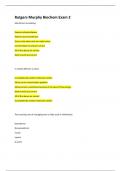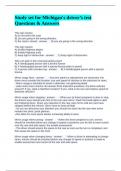Summary Introduction to
bioinformatics
BIF20306
Table of contents
Week 1. Introduction and databases......................................................................................................1
Week 2. Sequences................................................................................................................................3
Week 3. Evolution...................................................................................................................................5
Week 4. Structure and function..............................................................................................................9
Week 5. Omics......................................................................................................................................12
Week 1. Introduction and databases
Amino acid Three-letter code One-letter code Comment
Non-polar Glycine Gly G Only -H as side
chain
Alanine Ala A
Valine Val V
Leucine Leu L
Isoleucine Ile I
Proline Pro P Side chain to N
bond
Phenylalanine Phe F
Methionine Met M
Tryptophan Trp W
Cysteine Cys C Forms disulfide
bonds
Polar Asparagine Asn N Amide N polar
Glutamine Gln Q Amide N polar
Serine Ser S -OH group polar
Threonine Thr T -OH group polar
Tyrosine Tyr Y -OH group polar
Acidic Aspartic acid Asp D
Glutamic acid Glu E
Basic Histidine His H
Lysine Lys K
Arginine Arg R
The relationship between DNA, RNA and proteins has been described as the central dogma of
molecular biology. The information of DNA is transcribed into RNA in the process of transcription,
which is subsequently converted into proteins in the process of translation.
The genetic code refers to the correspondence between the 4-letter nucleotide alphabet of DNA and
the 20-letter amino acid alphabet of proteins.
The primary structure of a polypeptide is the amino acid sequence from the N- to the C-terminus.
The secondary structure of a protein is a description of its structure in terms of local alignments:
sheets, helices, turns.
1
, Turns are built up from 3 to 6 amino acids and cover a huge conformational space of the protein
backbone. They are important for the protein globularity.
Loops are structural elements that consist of multiple turns and connects helices and sheets.
The tertiary structure describes the 3D arrangement and placement of secondary structural
elements. It specifies protein properties.
The amino acid interactions include hydrogen bonds, disulfide bridges, ionic bonds and hydrophobic
interactions.
The quaternary structure is the arrangement of several polypeptide subunits. The assembly is carried
out through noncovalent interactions.
mRNA is produced from 5’ (N-terminus) to 3’ (C-terminus). DNA read from 3’ to 5’.
The genome is the total pool of genomic DNA in an organism.
The transcriptome is the total pool of mRNA in an organism.
The proteome is the total pool of proteins in an organism.
DNA and RNA differ in composition of their nucleotides. While in DNA deoxyribose is found as sugar
residue, in RNA this is replaced by ribose. Furthermore, in RNA, the base uracil replaces thymine.
DNA is present as a complementary double strand, whereas RNA is single-stranded.
In DNA, the base pairings A-T and C-G are seen. A purine ring (Adenine or Guanine) is paired with a
corresponding pyrimidine (Thymine, Cytosine or Uracil). Two hydrogen bonds are formed in the base
pairing of A-T, whereas three such bonds are formed in the pairing of C-G.
Primary databases contain primary sequence information and accompanying annotation information
regarding function, bibliographies, and so on.
Secondary databases summarize the results from analyses of primary protein sequence databases.
Biological databases
Primary databases DNA sequences Genbank, ENA, DDBJ
Protein sequences Uniprot (Swissprot=annotated and reviewed),
TrEMBL=annotated, not reviewed, PIR)
Protein structures PDB
Secondary databases Motifs Prosite
Profiles/domains Pfam
Protein folds SCOP, CATH
Other databases Multiple sequence MAFFT
alignment
Phylogenetic trees MegaX
Amino acid composition PIR
Calculate maximum IQ tree
likelihood trees and their
bootstrap analysis
Secondary structure 2struc, raptorX, TMHMM, expasy
3D structure PDBsum
Motifs are short sequence regions that are conserved in related proteins and usually have a key role
in the protein’s function.
A profile is a pattern that evaluates the probability of the appearance of a given amino acid, an
insertion, or a deletion at every position in a protein sequence.
Binary files are all the files that are non-text files.
Redundancy occurs when the same sequence is deposited multiple times or when several databases
2
bioinformatics
BIF20306
Table of contents
Week 1. Introduction and databases......................................................................................................1
Week 2. Sequences................................................................................................................................3
Week 3. Evolution...................................................................................................................................5
Week 4. Structure and function..............................................................................................................9
Week 5. Omics......................................................................................................................................12
Week 1. Introduction and databases
Amino acid Three-letter code One-letter code Comment
Non-polar Glycine Gly G Only -H as side
chain
Alanine Ala A
Valine Val V
Leucine Leu L
Isoleucine Ile I
Proline Pro P Side chain to N
bond
Phenylalanine Phe F
Methionine Met M
Tryptophan Trp W
Cysteine Cys C Forms disulfide
bonds
Polar Asparagine Asn N Amide N polar
Glutamine Gln Q Amide N polar
Serine Ser S -OH group polar
Threonine Thr T -OH group polar
Tyrosine Tyr Y -OH group polar
Acidic Aspartic acid Asp D
Glutamic acid Glu E
Basic Histidine His H
Lysine Lys K
Arginine Arg R
The relationship between DNA, RNA and proteins has been described as the central dogma of
molecular biology. The information of DNA is transcribed into RNA in the process of transcription,
which is subsequently converted into proteins in the process of translation.
The genetic code refers to the correspondence between the 4-letter nucleotide alphabet of DNA and
the 20-letter amino acid alphabet of proteins.
The primary structure of a polypeptide is the amino acid sequence from the N- to the C-terminus.
The secondary structure of a protein is a description of its structure in terms of local alignments:
sheets, helices, turns.
1
, Turns are built up from 3 to 6 amino acids and cover a huge conformational space of the protein
backbone. They are important for the protein globularity.
Loops are structural elements that consist of multiple turns and connects helices and sheets.
The tertiary structure describes the 3D arrangement and placement of secondary structural
elements. It specifies protein properties.
The amino acid interactions include hydrogen bonds, disulfide bridges, ionic bonds and hydrophobic
interactions.
The quaternary structure is the arrangement of several polypeptide subunits. The assembly is carried
out through noncovalent interactions.
mRNA is produced from 5’ (N-terminus) to 3’ (C-terminus). DNA read from 3’ to 5’.
The genome is the total pool of genomic DNA in an organism.
The transcriptome is the total pool of mRNA in an organism.
The proteome is the total pool of proteins in an organism.
DNA and RNA differ in composition of their nucleotides. While in DNA deoxyribose is found as sugar
residue, in RNA this is replaced by ribose. Furthermore, in RNA, the base uracil replaces thymine.
DNA is present as a complementary double strand, whereas RNA is single-stranded.
In DNA, the base pairings A-T and C-G are seen. A purine ring (Adenine or Guanine) is paired with a
corresponding pyrimidine (Thymine, Cytosine or Uracil). Two hydrogen bonds are formed in the base
pairing of A-T, whereas three such bonds are formed in the pairing of C-G.
Primary databases contain primary sequence information and accompanying annotation information
regarding function, bibliographies, and so on.
Secondary databases summarize the results from analyses of primary protein sequence databases.
Biological databases
Primary databases DNA sequences Genbank, ENA, DDBJ
Protein sequences Uniprot (Swissprot=annotated and reviewed),
TrEMBL=annotated, not reviewed, PIR)
Protein structures PDB
Secondary databases Motifs Prosite
Profiles/domains Pfam
Protein folds SCOP, CATH
Other databases Multiple sequence MAFFT
alignment
Phylogenetic trees MegaX
Amino acid composition PIR
Calculate maximum IQ tree
likelihood trees and their
bootstrap analysis
Secondary structure 2struc, raptorX, TMHMM, expasy
3D structure PDBsum
Motifs are short sequence regions that are conserved in related proteins and usually have a key role
in the protein’s function.
A profile is a pattern that evaluates the probability of the appearance of a given amino acid, an
insertion, or a deletion at every position in a protein sequence.
Binary files are all the files that are non-text files.
Redundancy occurs when the same sequence is deposited multiple times or when several databases
2











